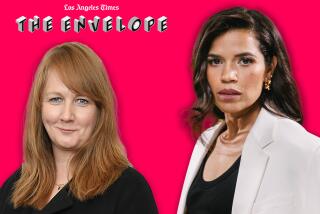So Who’s Really Making Such a Big Deal About Color?
- Share via
The old man is shuffling after the little girl, who is doing a cross between a skip and a run down the store aisle bracketed with toys. She is giddy with excitement. He looks tired. There could be 70 years between them.
“Whatever you want, honey,” the old man is saying. “Just pick out what you like.”
She is torn. He is in a hurry. She is holding a Barbie doll but eyeing a squeezable Oscar the Grouch. Barbie is black. Oscar is lime green.
“You want this? Is this what you want?” the old man asks. He pulls Oscar from his perch. “Here. This is nice.”
But the little girl, blondish, 3-ish, hesitates. She sizes up the trash can monster and the plastic woman, African-American flavored, and then she puts Oscar back. The old man gives an almost imperceptible shrug.
“OK, fine,” he says. “Whatever you want.” The two leave, hand in hand.
And I wonder what Barbie’s reception might be at home.
My own daughter, the proud kindergarten graduate, would have chosen differently, I believe. She would have dismissed Oscar as a “baby thing,” maybe something for her little sister, and then politely declined Barbie as well.
She would have told me that she prefers blondes, like herself and many of her friends and like almost every woman whom she sees on TV.
Even at 5 years old, my daughter is polite when the two of us talk about such things, but in a different way. It’s more like a verbal dance that we do, an erratic fandango, hot and cold. Our conversations never mention the word race .
But my daughter senses something strange about these talks, maybe in my tone, maybe in all the questions. Like my other queries that begin with, “What would you do if a stranger . . . “ maybe she thinks there is a right way to answer me and a wrong.
She is right, of course, but I try not to let on. Sometimes she searches my eyes for clues. Is honesty really best?
I try to act as if I were asking about her preference for cherry yogurt over the raspberry variety that she leaves untouched.
“Well, how come you only want blond dolls?” I’ll say. “Doesn’t that get boring after a while?”
My daughter will say that no, she is not bored with the blondes, or the occasional redhead, and then she’ll add that she just likes them better. And I’ll ask her why that might be.
“They’re prettier,” my daughter says.
Usually, I’ll let it drop. “The child is 5,” I tell myself. But then another time, I am reminded that 5 is old enough. When does preference harden into prejudice? Early on.
I grew up in suburbia myself, mostly insulated from children of races other than my own. My father would occasionally mention his own upbringing, in inner-city Pittsburgh, where the blacks “drove out” the Jews. Only my father’s terms weren’t always this polite.
I don’t remember talking with my own parents much about race back then. It didn’t seem important; somehow, I always figured I knew how they felt. A kid picks things up.
Now, as a mother, I find myself looking for meaning in the color of a doll’s hair or the tint of the plastic used for her skin. Where do these “preferences” begin and where do they end? To what extent should I butt in?
My own daughters’ upbringing is much more “multiracial” than was my own. This is not something that either my husband or I set out to engineer. Our older daughter was born in Mexico City, and today she speaks English and a kid variation of Spanglish. Her friends are Latino, Asian, white and black.
Still, the differences among them seem to be mattering more to her as she grows up. As a toddler, skin color mattered much less than did a fellow toddler’s grin.
Now she’ll tell me that she likes the way that one friend looks, whereas the other one she likes less. Her concept of beauty mimics what she sees on the tube. In my mind, I worry about pattern: Fair over dark, light equals nice.
Yet I think I may be seeing implications where there are none. So our verbal dance begins.
“Honey, you know that somebody’s skin doesn’t have anything to do with what type of a person they are,” I’ll say.
My daughter will grow silent and wide-eyed then. “I know,” she says.
And I want to believe that she does. So who is making this color thing a big deal? I shudder to think that it could be me. Kids pick things up.
More to Read
The biggest entertainment stories
Get our big stories about Hollywood, film, television, music, arts, culture and more right in your inbox as soon as they publish.
You may occasionally receive promotional content from the Los Angeles Times.










